History of Baseball Video Games #6 - Atari's RealSports Baseball
By jbn566 2 Comments
This is a series of blogs based on my own personal game collection. I will attempt to go through them in a chronological order according to their release date. I will also attempt to play then on their original platform using the original controllers the game was designed for. If I am unable to get the system or the game working then I will use PC emulation or another platform emulation like the Intellivision Lives! game for the gamecube
Previous entries
| 5. Microvision's Baseball (1980) |
RealSports Baseball for Atari 2600 (1982)
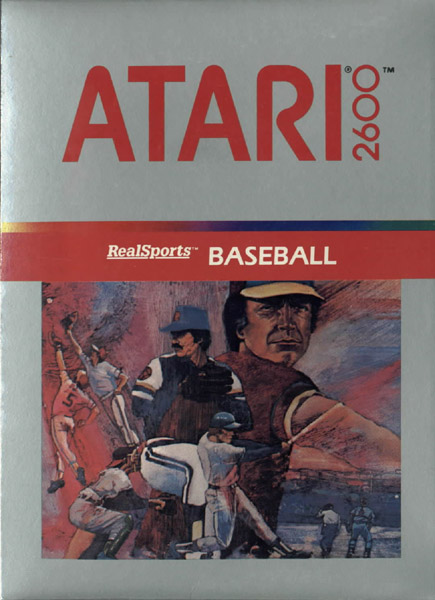
The year is 1982, one year before the 'Video game crash of 1983'. In 1980 Intellivision beat up on Atari's earlier baseball game, Home Run (1978), by including screenshot of Home Run next to newest 'Major League Baseball' game both in printed and video media. It reminds me of the Sega's "Nintendon't" ad campaign. Atari had to fight back thus they created a new line of sport games, 'RealSports' in the early 80's. Atari finally completed development and released RealSports Baseball for the 2600 in 1982. Two years after Intellivision's Major League Baseball. Sadly I do not own a cartridge of this game only the Xbox emulation of the game via GameRoom, so I will base this blog on this version. Does Atari successfully retaliate and one up Intellivision's baseball? Let’s find out
Graphics
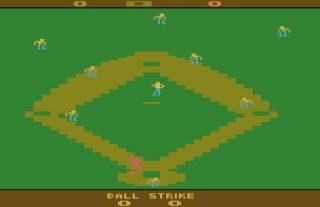
Umm....well It is an improvement over their first entry, Home Run, but it's enough to derail Intellivision's aggressive ad campaign. Atari managed to successfully put 9 players out on the field so I give them points for that and some minor points for displaying a baseball diamond but we are in 1982 and those things are really standard now. The biggest improvement Atari did do in terms of graphics is the text. The text in the game is easy to read and understand. I like how they created a separate box for the on screen text and game info. Previous games including Intellivision's, all the text were huge and printed right on the field with the green background behind it.
Players
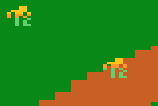
The players are more defined then Home Run's rendering but equal to that of Intellivision's player model. We do not have baseball hats in this game which is a little sad since Home Run was one of the first to pull that off. This game the players all look the same based on their general role in the game. All fielders look the same, the pitcher is different as well as the batter. The batter does swing his body when you attempt to hit the ball. The pitcher also has a quick animation for its windup.
Field
| Atari's RealSports Baseball (1982) | Intellivision's Major League Baseball (1980) |
|---|---|
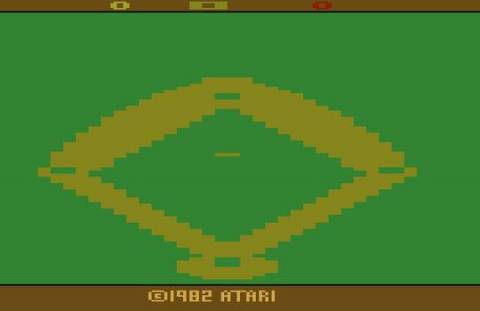 | 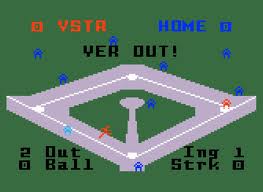 |
Wow we have a baseball field, oh what a dirty ugly field it is. I don't think I have seen so many jagged lines in a video game before. Just compare the two games and you see how weak the Atari was in rendering diagonal lines. This game doesn't really advance the field in any way. The colors are also dull, It does render the diamond in the correct dirt brown color, unlike the Intellivision's concrete look. The bases are just small lines including the pitcher's mound. The one nice thing is that because the on screen text is separate from the field we get a full view of the field and the players.
Fans
It is 1982 and we still don't have any sort of crowd or fans displayed during the game.
Home Run Celebration
When you hit a home run, the words 'HOME RUN' appear in the bottom line of text and there is some sort of noise coming from the machine. This game does provide one of the first of its kind regarding home runs. In this game because you have to control the base runner after every hit, it doesn't make an exception for home runs. When you hit a home run you have to manually run around and touch all the bases yourself before the next pitch can be thrown. This might be fun while playing against another player for you can walk around the bases if you want. You can get up and make a ham sandwich, come back and finish your celebration in style.
Camera/Screen
There is only one camera angle used in this game. The angle of the gameplay is less bird's eye view and more behind the plate in the nose bleed seats. This is a standard view for baseball games in the early 80's.
Sound
You should be happy this blog is unable to produce the sounds that this game produces. It has sound for the hit, and a little beep when a ball lands in the glove of a fielder. The sound would be good if they just didn't have the noise for the strikes. Strikes produce this low pitch noise that feels like I just broke something. There is no background music.
Gameplay - Modes
Like any good Atari game, there are multiple game modes. This game has 4 modes, 2 modes for a two player game and 2 modes for a one player game. All modes deal with a single baseball game.
- Game 1: 2 player game, Player 1 starts in the outfield, Player 2 starts at bat. Batter can hit every pitch.
- Game 2: 2 player game, Player 1 starts at bat, Player 2 starts in the outfield, Batter cannot hit balls.
- Game 3: 1 player game, Player starts in the outfield, Batter cannot hit balls.
- Game 4: 1 player game, Player starts at bat, Batter cannot hit balls.
I know you probably wondering about the fact that batters can or can not hit balls is all about. Trust me it is a weird concept and I will explain it more in the Gameplay section.
Gameplay - Defense
I will give this game a pass when it comes to defense. The Atari is limited by the controller; there is just not much you can do with a joystick and one button. You can get away with it in space shooters or games where you only control one object or thing on the screen. With baseball you control a entire team, you control 9 different objects that are on the screen at any given time. Atari developers have to be more creative in coming up with ways to pass this control to the gamer in a way that doesn't hurt the gameplay. This game is does have a learning curve to it, the control is not as natural as it seems. Lets start with pitching.
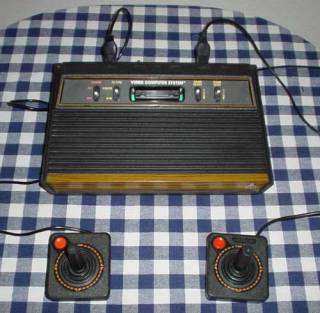
Instead of just pitching using the button and the joystick to control the curve of the ball, this game has predefined pitch types that you select by pointing the joystick in a direction; down for fastball, down for intentional ball...etc Once you make your selection you hold the button down and flick the joystick down towards the batter. The confusing part of the pitch is that every pitch looks exactly the same. Every pitch from a visual prospective is thrown directly in the center of the plate. There are no visual clues if you selected the correct pitch. Each pitch has a random variable of it produces a strike or a ball, except the 'intentional ball'. The fielding also takes some time to get use to. Once you collect the ball you are free to run around with the ball in hand or throw it to a base; up for second base, down for home plate. It takes some getting use to because the fielder throws the ball not to the base itself but towards the fielder that is covering the base which never stands on the base so you have to do some additional running.
Gameplay - Offense

We have ultimate control of the base runners, including stealing a base. To steal a base first we have to tell the CPU that was want to control the base runner by pressing the button and the direction of the base. After this is done the base runner is highlighted, moving the joystick to the right advances the runner. This is a creative way to add more control to the gamer but the highlighting the base runner more or less tips off the other player that you are about to steal. To hit the ball you can attempt to call your shot but moving the joystick in a certain position as you swing; up for long fly ball; down for bunt. I found that it didn't work 100% of the time and not sure if that was by design or just the case of bad controls. In truth we are all not Babe Ruth and maybe this game forces us to eat humble pie.
Rules of Baseball
This game is a great example of evolution of developers doing more with less and learning from the past. This game runs on the same system as Home Run. The technology didn't improve but yet we now have 9 players on the field, we have an actual field. we have complex baseball concepts such as throwing, base stealing, double plays. There isn't much this game doesn't have in terms of pure baseball, it just doesn't do anything new to video game baseball
Video Game Innovations
- Attempt at colorful uniforms
- complete control of all base runners
- control of direction of a base hit
- control of home run walk around the bases
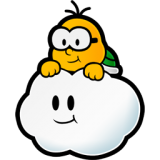
2 Comments